There is War in Ukraine
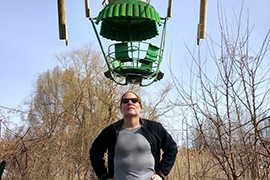
Editor’s note: Michael A. Denner, Ph.D., Stetson professor of Russian, East European, and Eurasian Studies, returned this month from a sabbatical that included a trip to Ukraine, where a three-year war with pro-Russian Ukrainians has left 10,000 people dead. In this excerpt, Denner describes a side trip to Sloviansk, Ukraine, with former Stetson professor Mark Powell. Read Denner’s complete article.
On March 10th,
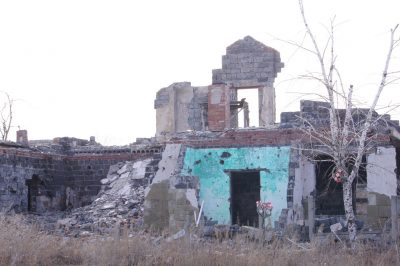
Mark Powell arrived in Kiev with his photojournalist buddy, Pete Duvall, in tow. The next night we set off for Sloviansk on an overnight train that could have been built in 1955 or 2015 … it’s hard to know in Ukraine.
Like so many places on the periphery of the former Soviet empire, nothing had changed much in Sloviansk since the end of the Soviet empire in 1992. It was monochromatic shades of grey, dusty, full of rubble, sunflower stubble.
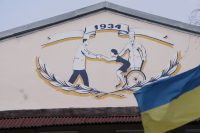 The flat landscape, pitted with brackish ponds and thrushes, had been a salt-mining region in the eighteenth century, nothing much in the nineteenth, and a vibrant manufacturing hub during the Soviet century. In the twenty-first century, it’s returned to nothing much. Everyone who could leave, left a long time ago for Kiev and western points beyond. People there cobble together livelihoods from odd-jobs in the few remaining factories and their kitchen gardens.
The flat landscape, pitted with brackish ponds and thrushes, had been a salt-mining region in the eighteenth century, nothing much in the nineteenth, and a vibrant manufacturing hub during the Soviet century. In the twenty-first century, it’s returned to nothing much. Everyone who could leave, left a long time ago for Kiev and western points beyond. People there cobble together livelihoods from odd-jobs in the few remaining factories and their kitchen gardens.
Think southern Ohio with Ladas.
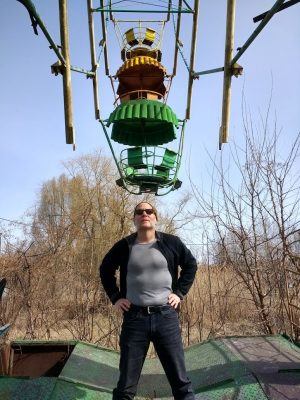
Peaceful enough, the only signs of war there are the mortar scars and frequent roadblocks manned by young soldiers carrying AK-47s.
We spent a few days in the back of (our fixer) Yuri’s taxi. He took us to all the “top secret” places where the Ukrainians were hiding stockpiles of missiles and heavy tanks, in contravention to the Minsk Accords signed by Ukraine and Russia in 2015.
We found an amusement park, built during the Soviet era but now forgotten and eerily rusting out of existence. We stopped at the point on the highway where an Italian journalist had been killed, and gazed at the crash site of a Ukrainian military helicopter that had been shot down by pro-Russian forces in 2014.
We toured the city administration building, made famous when, in 2014, the Vice journalist Simon Ostrovsky was taken into “protective custody” by Russian punks posing as politicians.
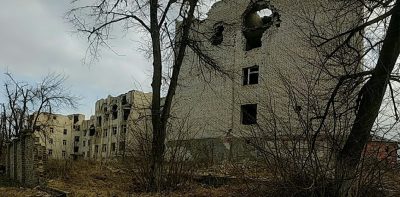 We surveyed roads and roadside houses pitted by mortar shells.
We surveyed roads and roadside houses pitted by mortar shells.
Most memorably, we wandered through the ravaged ruins of a durdom complex, three buildings that had served as an insane asylum until, in the summer of 2015, the pro-Russian insurgents had retreated there, and been blown to bits by Ukrainian special forces and, apparently, a helicopter or two.
Our driver told us more than a hundred people had died there, including many patients who were too sick to be evacuated in time. We found there cheerily painted walls exposed to the bleak landscape when the room was peeled open by 152 mm mortar fire. Black bras and red socks lay amidst the crumbling walls. Tables with intake records still tucked in drawers. The menu for tomorrow’s breakfast. Evening came and the cowbirds arrived, forming flocks and finally murmurating in ragged formations.
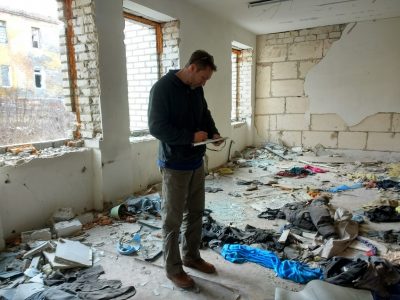
We fled, leaping from first floor windows, back to Yuri’s waiting car when the Ukrainian soldiers showed up …
This being a fully modern war, we ended our days with nights in the Taler bar, drinking excellent local brew, eating lamb kebabs, and chatting with munitions experts from Europe who were there demining the sunflower fields.
War, in all its stupidity, leaves behind mostly rubble, Mark observed. War is messy, it accelerates entropy, the falling apart of things, leaving behind first horrible carnage and then just monochromatic bleakness. It was obvious to us that war in Ukraine was just abiding, waiting until some opportune moment to first flicker, then flame, then rage.
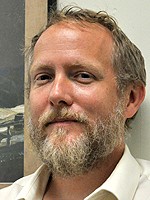
Michael Denner, Ph.D., is the director of the Stetson University Honors Program, a professor of Russian, East European, and Eurasian Studies, and editor of the Tolstoy Studies Journal, an annual refereed journal.
Former Stetson professor Mark Powell also wrote about this trip to Sloviansk, Ukraine, for the Daily Beast. Powell’s latest novel is Small Treasons.



